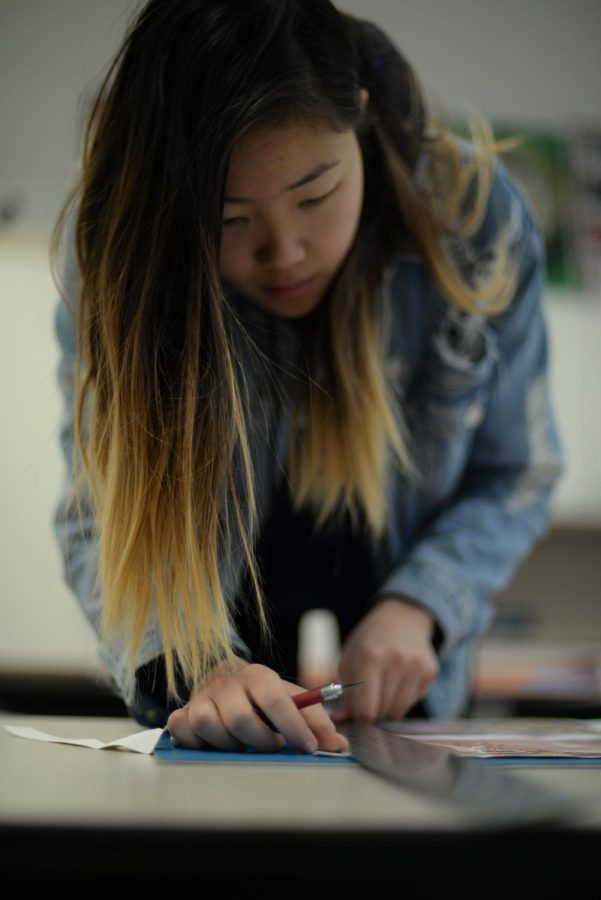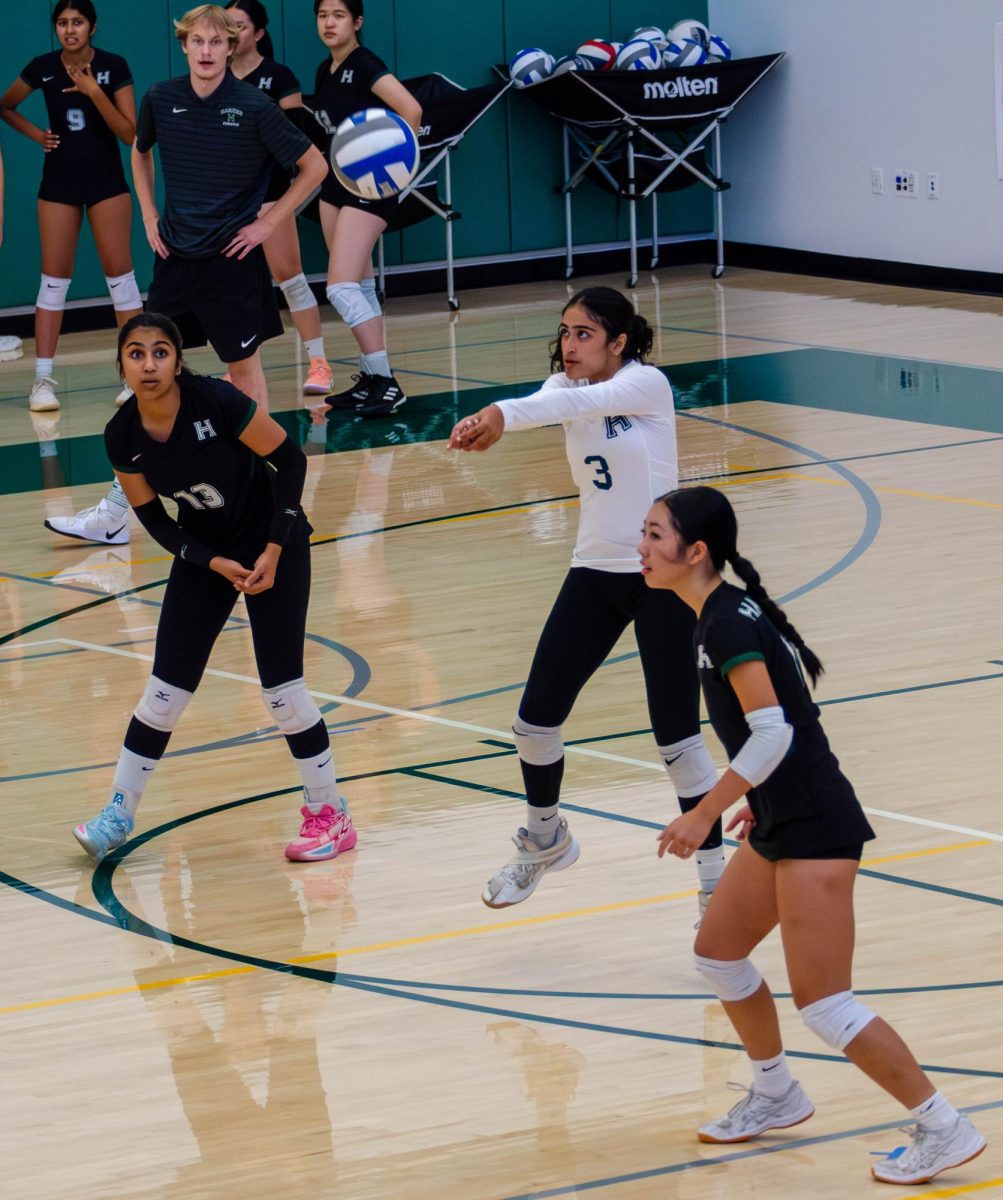Humans of Harker: Alisa Su thinks through her designs
“Different colors make me feel different ways,” Alisa Su (12) said. “The combination of it and going through that process makes me really happy. Mixing colors is one of the most beautiful processes of art to me. I absolutely hate it when people take the tube and straight up start using the color.”
February 28, 2018
Go-to graphic designer, paint mixer, people person — as an artist, Alisa Su (12) uses her extroverted personality to her advantage.
“One of her greatest talents is her ability to understand people. She’s often thought of as a social butterfly. It’s gotten to the point where now, whenever we see things, or remember things, and we look at each other, it’s almost like you don’t have to speak about what it is,” her friend Dolan Dworak (12) said of their friendship of five years.
Rahul Mehta (12)’s first impression of Alisa was “super tall” — she stands at 6’2’’ and is often jokingly compared to NBA basketball players. But as he got to know her, she became one of his closest friends.
“She has a lot of nicknames, but I think that’s because so many people know her,” Rahul said. “They all ingrain their own impression of her onto whatever they call her — Su, Suflake, Subear. She’s the one person who I can always talk to about anything. It’s like that saying, like ‘you always return back to home’ or something. I can always talk to her no matter what.”
She would never admit it, but according to her friends, she has a gift for knowing exactly what to say. And according to Dolan, she also has a reputation among the senior class for another gift: art.
“She’s an artistic visionary who wants to and will save the world of design in the next 50 years,” Dolan said.
Alisa finds that art, above any other subject, has the ability to captivate her attention. She began classes in 2nd grade as a way to channel her creative energy.
“I have trouble focusing because I have ADD [attention deficit disorder], but when I’m enraptured in something I really like to do, I can be in that mindset 100%,” she said. “I don’t need music or anything to focus.”
From her plethora of logo designs to her work for Silicon Valley Design-It, Alisa’s style reflects her modern aesthetic.
“A lot of my work is conceptual,” she said. “I struggle with confronting my own emotions. The feeling i get through painting helps me deal with my emotions, even if I don’t know that I’m expressing myself being sad or mad. The thing is, I don’t express myself in art to express it to other people. It’s for myself.”
With their plethora of connotations, colors offer a way to pinpoint places along a wide spectrum of emotion.
“Different colors make me feel different ways,” she said. “The combination of it and going through that process makes me really happy. Mixing colors is one of the most beautiful processes of art to me. I absolutely hate it when people take the tube and straight up start using the color.”
According to her friend Ashna Chandra (12), Alisa found her independence in art.
“She started off different in lower school and cared more about what people thought,” Ashna said. “As she got into high school, she got more involved with her art and that helped show her creative personality. She’s such a strong person if you get to know her.”
Alisa’s artistry and individuality developed simultaneously.
“Before, I felt like I had to prove myself to my parents and other people,” she said. “I realized that letting others’ opinions get to me was only holding me back. You’re living your own life and even if other people see you in a different light, they’ll never experience everything that you experience, and they don’t really understand you. Once you feel like you don’t need to prove yourself to people is when you can focus on the things that you can do for yourself.”
Alisa said. “I’ve never been influenced much by others but my education has brought me more into what I want to be. I have a really vivid image of what I want to do in life and that’s never really changed.”
This mindset has allowed her to take feedback, both positive and negative, with a grain of salt.
“I have a really strong sense of self. I know what I like and I know what I want. In art class at school, I get a lot of weird looks when I try new things,” she said. “But people who criticize my art doesn’t really affect me. It obviously hurts when you work so hard on something, and it’s not accepted, but at the same time art is so subjective. The outcome will be best if you keep doing what you want to do.”
Additional reporting by Humans of Harker managing editor Melissa Kwan.


















![“[Building nerf blasters] became this outlet of creativity for me that hasn't been matched by anything else. The process [of] making a build complete to your desire is such a painstakingly difficult process, but I've had to learn from [the skills needed from] soldering to proper painting. There's so many different options for everything, if you think about it, it exists. The best part is [that] if it doesn't exist, you can build it yourself," Ishaan Parate said.](https://harkeraquila.com/wp-content/uploads/2022/08/DSC_8149-900x604.jpg)




![“When I came into high school, I was ready to be a follower. But DECA was a game changer for me. It helped me overcome my fear of public speaking, and it's played such a major role in who I've become today. To be able to successfully lead a chapter of 150 students, an officer team and be one of the upperclassmen I once really admired is something I'm [really] proud of,” Anvitha Tummala ('21) said.](https://harkeraquila.com/wp-content/uploads/2021/07/Screen-Shot-2021-07-25-at-9.50.05-AM-900x594.png)







![“I think getting up in the morning and having a sense of purpose [is exciting]. I think without a certain amount of drive, life is kind of obsolete and mundane, and I think having that every single day is what makes each day unique and kind of makes life exciting,” Neymika Jain (12) said.](https://harkeraquila.com/wp-content/uploads/2017/06/Screen-Shot-2017-06-03-at-4.54.16-PM.png)








![“My slogan is ‘slow feet, don’t eat, and I’m hungry.’ You need to run fast to get where you are–you aren't going to get those championships if you aren't fast,” Angel Cervantes (12) said. “I want to do well in school on my tests and in track and win championships for my team. I live by that, [and] I can do that anywhere: in the classroom or on the field.”](https://harkeraquila.com/wp-content/uploads/2018/06/DSC5146-900x601.jpg)
![“[Volleyball has] taught me how to fall correctly, and another thing it taught is that you don’t have to be the best at something to be good at it. If you just hit the ball in a smart way, then it still scores points and you’re good at it. You could be a background player and still make a much bigger impact on the team than you would think,” Anya Gert (’20) said.](https://harkeraquila.com/wp-content/uploads/2020/06/AnnaGert_JinTuan_HoHPhotoEdited-600x900.jpeg)

![“I'm not nearly there yet, but [my confidence has] definitely been getting better since I was pretty shy and timid coming into Harker my freshman year. I know that there's a lot of people that are really confident in what they do, and I really admire them. Everyone's so driven and that has really pushed me to kind of try to find my own place in high school and be more confident,” Alyssa Huang (’20) said.](https://harkeraquila.com/wp-content/uploads/2020/06/AlyssaHuang_EmilyChen_HoHPhoto-900x749.jpeg)










